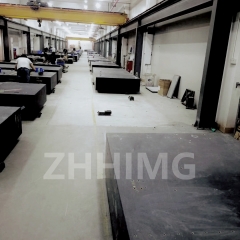In the "super factory" of chip manufacturing, each wafer the size of a fingernail carries precise circuits, and the key to determining whether these circuits can be precisely formed is actually hidden in an unremarkable stone - this is granite. Today, let's talk about the "secret weapon" of granite - its damping capacity - and how it becomes the "guardian angel" of wafer scanning equipment.
What is damping? Can stones also "absorb vibrations"?
Damping sounds very professional, but in fact, its principle is very simple. Imagine you suddenly stop while running. If there is no cushioning, your body will rush forward due to inertia. And damping is like an invisible hand, helping you to "brake" quickly. The internal structure of granite is composed of interwoven mineral crystals such as quartz and feldspar, and there are many tiny crevices and friction points between these crystals. When external vibrations are transmitted to the granite, these crevices and friction points start to "work", converting the energy of the vibrations into heat energy and gradually dissipating it, allowing the vibrations to stop quickly. This is just like installing a "super shock absorber" on the device, making it no longer "shake hands".
Wafer scanning: A tiny mistake can lead to a huge error
Wafer scanning devices are like precision cameras that "take pictures" of wafers, detecting and drawing circuit patterns at the nanoscale. However, during the operation of the equipment, the rotation of the motor and the movement of mechanical components will both generate high-frequency vibrations. If these vibrations are not controlled, the scanning lens will "blurry" like an unstable camera, resulting in inaccurate detection data and even directly scrapping the entire wafer.
When a common metal base encounters vibration, it often "hits hard against hard", with the vibration reflected back and forth within the metal, becoming more and more severe the shaking. Granite, with its excellent damping capacity, can absorb more than 80% of the vibration energy. A real case of a certain semiconductor factory shows that before the granite base was replaced, the edges of the wafer images taken by the scanning equipment were blurry, with a deviation as high as ±3μm. After switching to a granite base, the image clarity was significantly improved, the deviation was reduced to ±0.5μm, and the yield rate soared from 82% to 96%!
Resonance Crisis: How Does Granite "Defuse the Danger"?
Apart from the vibration of the equipment itself, minor vibrations from the external environment (such as the operation of machines next door or the footsteps of workers walking) may also cause major troubles. When the external vibration frequency is consistent with the frequency of the equipment itself, resonance will occur, just like shaking jelly, the greater the amplitude the more you shake. The damping characteristics of granite are like putting "soundproof earplugs" on the equipment, broadening the resonant frequency range of the equipment and making it less likely to be in sync with the outside world. Data shows that after using the granite base, the risk of equipment resonance has been reduced by 95%, and the stability has been improved by three times!
The enlightenment of "damping" in life
In fact, the principle of damping is also very common in daily life. The shock absorbers of a car enable us to drive smoothly on bumpy roads, and the noise-cancelling function of headphones can block out external noise. All these achieve stability by "absorbing energy". Granite has brought this ability to the extreme and has become an indispensable key material in the field of chip manufacturing.
Next time you see granite, don't just take it as an ordinary stone! In the sophisticated world of semiconductor manufacturing, it is precisely these seemingly ordinary materials that, with their unique "superpowers", drive technology forward continuously.
Post time: Jun-17-2025


